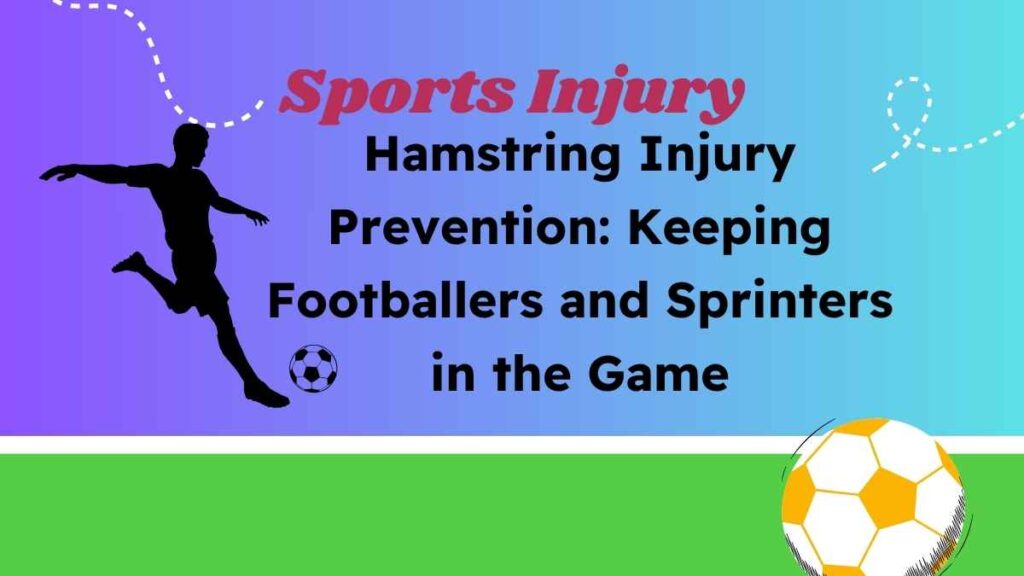Table of Contents
Hamstring Injury Prevention
Hamstring strains are the bane of every footballer, sprinter, and high-intensity athlete. That sharp, gut-wrenching pull in the back of your thigh can sideline you for weeks, if not months, derailing training and crushing game-day dreams. In sports like football and track, hamstring injuries make up nearly 20% of all injuries, with re-injury rates as high as 30%. Recent discussions on X highlight the frustration athletes face, but they also point to hope: evidence-based strategies can significantly reduce the risk. From motor control exercises to targeted strength training, let’s break down how to protect your hamstrings and stay on the field.
Why Hamstrings Are So Vulnerable in High-Intensity Sports
Hamstrings—a group of three muscles (biceps femoris, semitendinosus, and semimembranosus)—are critical for sprinting, cutting, and explosive movements. In football, a sudden sprint to chase a ball or a rapid change in direction can overload these muscles. Sprinters face similar risks during maximum-effort runs, where hamstrings work overtime to propel the body forward. The main culprits? Poor biomechanics, muscle imbalances, and inadequate warm-ups. Studies show that weak or tight hamstrings, combined with fatigue, skyrocket injury risk. X users, from amateur runners to pro coaches, often share tales of recurring strains, underscoring the need for smarter prevention.
Evidence-Based Strategies for Hamstring Injury Prevention
Preventing hamstring injuries isn’t about luck—it’s about science. Here are proven strategies, backed by recent research and real-world insights, to keep your hamstrings strong and resilient:
1. Master Motor Control Exercises
Motor control exercises focus on improving how your brain and muscles work together, ensuring smooth, efficient movements. Poor coordination during high-speed running often leads to hamstring strains. Here’s how to tackle it:
- Eccentric Hamstring Training: Exercises like Nordic hamstring curls are gold-standard for prevention. They strengthen the hamstrings during their lengthening phase, which is when most injuries occur. A 2024 study in the Journal of Sports Sciences found that teams incorporating Nordic curls reduced hamstring injuries by 50%. How to do it: Kneel on a mat, secure your ankles, and slowly lower your torso toward the ground, resisting with your hamstrings. Start with 3 sets of 6-8 reps, twice weekly.
- Single-Leg Balance Drills: These improve neuromuscular control, reducing strain during dynamic movements. Try single-leg Romanian deadlifts with a light dumbbell—focus on slow, controlled motion. Aim for 3 sets of 10 per leg. X users rave about how these drills improve stability during sprints.
2. Build Strength with Targeted Training
Strong hamstrings can handle the demands of high-intensity sports, but strength must be balanced with other muscle groups, like the quads, to avoid injury.
- Hamstring-to-Quad Ratio: Research suggests a 3:2 strength ratio between hamstrings and quads is ideal. Test this with gym equipment or consult a trainer. Strengthen hamstrings with exercises like deadlifts, glute-ham raises, and Swiss ball curls. Aim for 3 sets of 8-12 reps, focusing on form over heavy weights.
- Glute Activation: Weak glutes force hamstrings to overcompensate. Incorporate glute bridges or hip thrusts into your routine (3 sets of 12-15 reps). A 2023 study showed that stronger glutes cut hamstring strain risk by 25% in footballers.
- Core Stability: A strong core supports proper running mechanics. Planks, side planks, and Pallof presses (3 sets of 30-60 seconds) stabilize your pelvis, reducing hamstring stress.
3. Warm Up Smarter, Not Harder
A proper warm-up primes your hamstrings for action. Static stretching is out—dynamic warm-ups are in.
- Dynamic Warm-Ups: Include leg swings, walking lunges, and high-knee drills to boost blood flow and flexibility. Spend 10-15 minutes before practice or games. X posts from sprint coaches emphasize pairing these with foam rolling to release tight spots.
- Sport-Specific Drills: Mimic game movements at low intensity. For footballers, try short sprints with gradual acceleration. Sprinters can do A-skips or bounding drills to activate hamstrings safely.
4. Manage Fatigue and Recovery
Fatigue is a major risk factor for hamstring injuries, as tired muscles lose coordination. Recent discussions on X highlight how overtraining contributes to strains in youth and amateur athletes.
- Monitor Workload: Use apps or wearables to track training volume. Limit high-intensity sessions to 2-3 per week, with rest or low-impact days in between. A 2024 study found that athletes with balanced workloads had 30% fewer hamstring injuries.
- Prioritize Recovery: Post-training, focus on hydration, nutrition (protein-rich meals), and sleep (7-9 hours). Active recovery, like light cycling or yoga, keeps hamstrings loose without strain.
Rehabilitation Insights: Preventing Re-Injury
If you’ve already had a hamstring strain, re-injury is a real threat. Recent rehab protocols emphasize gradual progression and addressing root causes:
- Graded Return to Activity: Follow a structured rehab plan, starting with isometric exercises (like holding a bridge position) and progressing to eccentric movements. A physical therapist can guide you, but apps like PhysioTrack offer AI-driven plans for home use.
- Address Imbalances: Many re-injuries stem from untreated weaknesses, like tight hip flexors or weak glutes. Incorporate corrective exercises, like hip flexor stretches, into your routine.
- Patience is Key: Rushing back increases re-injury risk by 40%, per recent research. Wait for full strength and pain-free movement before returning to high-intensity sports.
X users share success stories of sticking to these protocols, with some footballers returning stronger after 6-8 weeks of dedicated rehab.
Putting It All Together: Your Hamstring Protection Plan
Preventing hamstring injuries requires a mix of preparation, strength, and smarts. Start with a dynamic warm-up, incorporate Nordic curls and glute exercises into your weekly routine, and monitor fatigue to avoid overtraining. For coaches, educate your team on proper form and advocate for recovery time. Recreational athletes can use affordable tools like resistance bands or apps to stay consistent.
Hamstring strains don’t have to be part of the game. By leveraging these evidence-based strategies, you can sprint, cut, and compete with confidence. Got a favorite hamstring drill or recovery tip? Share it with your community on X and keep the conversation going—together, we can keep athletes in the game and off the sidelines.

